Hi Tokyo! (Part One) updated 18 June
Right, so I am back from Tokyo. Touched down Singapore just past midnight on 14 June, and have been getting back into momentum these few days. The trip itself was quite a rambling one. I had gone on a free and easy individual trip, just me and myself. So I started off without a fixed iteniarary. I just had a vague fuzzy idea that I would probably roam around the few main districts of Tokyo, particularly those I had not visited the last time. It would be a walking tour, and I would explore the nooks and corners of these districts. I had also vowed not to purchase unnecessarily, as the Yen is quite exorbitant. Well, I did walk, I did explore the districts, and I did used the subway (numerous Asakusa Line, Ginza Line etc) and train (JR line) extensively. Food was kept to minimal expenditure, adhering to the basic lunch and dinner fare that the typical tokyo worker would take.
(Note: The photos below are collages. To view in bigger size, click on the photo and it will be in a new webpage. You could view the enlarged version in the new webpage. )
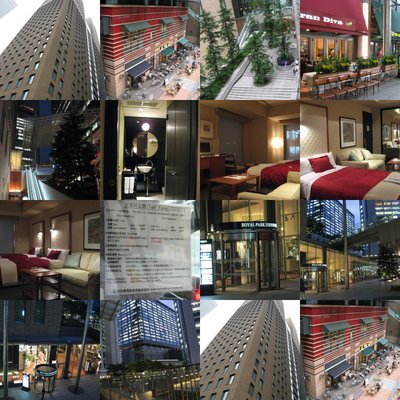 Anyway, there was good western buffet or Japanese breakfast to choose from each morning, accompanied with good vantage views of the city skyline from the 24th storey restaurant of Royal Park Shiodome Tower Hotel. I had on the spur of the moment decided to upgrade my room to a larger one, with views of the city as well as the offices of the adjacent Nippon TV Building. They are really workaholics, for the offices and their smoking galleries were lit and buzzing with activities even at 11 pm. Yes, I shamelessly did observe their activities from my room.
Anyway, there was good western buffet or Japanese breakfast to choose from each morning, accompanied with good vantage views of the city skyline from the 24th storey restaurant of Royal Park Shiodome Tower Hotel. I had on the spur of the moment decided to upgrade my room to a larger one, with views of the city as well as the offices of the adjacent Nippon TV Building. They are really workaholics, for the offices and their smoking galleries were lit and buzzing with activities even at 11 pm. Yes, I shamelessly did observe their activities from my room.(My Hotel and Room: Royal Park Shiodome Tower, just opposite the Nippon TV Tower Building. )
 Day 1, I walked the district (or chome) of Ginza (my avowed destination for this trip), and then decided to go up to Asakusa, revisit the temple, and then make my way down the Sumida River and say hello to the bridges that I have always wanted to visit. And it was a walk, with some referring to a map I took at the airport, and trying to figure out the kanji (Chinese charaters) and Japnese words. Somehow, I managed to complete the length of Ginza main street, filled with a heavenly selection of stores and cafes.
Day 1, I walked the district (or chome) of Ginza (my avowed destination for this trip), and then decided to go up to Asakusa, revisit the temple, and then make my way down the Sumida River and say hello to the bridges that I have always wanted to visit. And it was a walk, with some referring to a map I took at the airport, and trying to figure out the kanji (Chinese charaters) and Japnese words. Somehow, I managed to complete the length of Ginza main street, filled with a heavenly selection of stores and cafes.(Ginza with its range of high tech, luxury fashion and quaint coffee tea stores. Note the Nissan presentator on the revolving platform introducing the merits of the latest car model. )
 But it was simply too far to walk all the way up to Asakusa and Sensoji (one of the most ancient temples in Tokyo), so I finally made my way into Ginza East subway station, hoped onto the Asakusa Line, and emerged from Asakusa Station some 20 minutes later. It was a good day to visit, I should say. The first shock was the disappearance of the main Sensoji Gate, now shrouded under modernistic looking white coverage cloth - under conservation works. Then, there were so many school children on outing, and buying and praying there. I think it was the end of spring school term, and this would be their end of term outing - it included high school students as well as middle school students. Then on my way out, there were little kids as well. It was indeed good timing for me.
But it was simply too far to walk all the way up to Asakusa and Sensoji (one of the most ancient temples in Tokyo), so I finally made my way into Ginza East subway station, hoped onto the Asakusa Line, and emerged from Asakusa Station some 20 minutes later. It was a good day to visit, I should say. The first shock was the disappearance of the main Sensoji Gate, now shrouded under modernistic looking white coverage cloth - under conservation works. Then, there were so many school children on outing, and buying and praying there. I think it was the end of spring school term, and this would be their end of term outing - it included high school students as well as middle school students. Then on my way out, there were little kids as well. It was indeed good timing for me.(Indeed, I should comment that this trip is filled with providential timing coincidents indeed. I happened to travel on the same plane as NJC chinese orchestra, and so saw some of my former students at the airport and on the plane. Also, at Changi Airport after check-in, I bumped into my former symphony orchestra friend whom i have not seen for years, and so we had a good coffee chat before we went our respective way - he to Spain while I to Japan.)
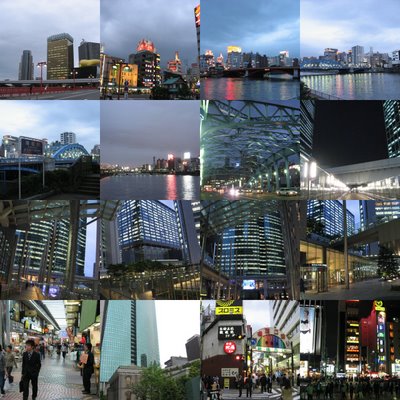 Anyway, the walk down Sumida River was a long one. I had chosen to walk in the evening, as that would best set off the colours of the lit bridges. I walked for about 2 odd hours, and with the cold spring temperature of some 20 degrees at night with the wind blowing right into my face, it was quite a task - not as enjoyable as I had envisage. And the riverside was nothing spectacular, not even to consider beautiful or nice. It was mainly either dingy muddy parks, or slumps. It was not at all like our vibrant al fresco riverside back home. I only managed to cover 3 bridges before calling it a day. I decided to leave the remaining bridges to my next trip.
Anyway, the walk down Sumida River was a long one. I had chosen to walk in the evening, as that would best set off the colours of the lit bridges. I walked for about 2 odd hours, and with the cold spring temperature of some 20 degrees at night with the wind blowing right into my face, it was quite a task - not as enjoyable as I had envisage. And the riverside was nothing spectacular, not even to consider beautiful or nice. It was mainly either dingy muddy parks, or slumps. It was not at all like our vibrant al fresco riverside back home. I only managed to cover 3 bridges before calling it a day. I decided to leave the remaining bridges to my next trip.Sumida River and the 3 bridges I visited.
Night scenes of my hotel, and the vicinity of Shiodome (Japenese of Lingering Sealand) and Shimbasi (Japanese for New Bridge).
 I had not counted on my impulse to purchase. And that I did. So I bought, and bought - in Ginza, in Shiodome, in Ueno, in Odaiba. I devoured suits, clothes, pants, books, DVDs, CDs, souvenirs. I burst my budget in the process. So in the end, I lingered for hours in shopping districts, and in their shops with rows and rows of trendy working suits, and browsed the attractive magazines and books. I did eat too, and that was a highlight - trying out the respective little eateries frequented by the office executives, standing or sitting at the counters, and then for supper, choosing from the different bento sets all available at stores and superstores ... at a discount of course, esp late a night. They were mainly simple fare of some 450Yen per meal, and the bento sets were even going at discounted price of 350Yen after 9pm. All in all, I only spent some 200 odd Singapore Dollars on food this round, excluding the hotel breakfasts.In retrospect, I should be satisfied with this break, for I just simply gave way to my impulses and went by my instinct every moment of the day there.
I had not counted on my impulse to purchase. And that I did. So I bought, and bought - in Ginza, in Shiodome, in Ueno, in Odaiba. I devoured suits, clothes, pants, books, DVDs, CDs, souvenirs. I burst my budget in the process. So in the end, I lingered for hours in shopping districts, and in their shops with rows and rows of trendy working suits, and browsed the attractive magazines and books. I did eat too, and that was a highlight - trying out the respective little eateries frequented by the office executives, standing or sitting at the counters, and then for supper, choosing from the different bento sets all available at stores and superstores ... at a discount of course, esp late a night. They were mainly simple fare of some 450Yen per meal, and the bento sets were even going at discounted price of 350Yen after 9pm. All in all, I only spent some 200 odd Singapore Dollars on food this round, excluding the hotel breakfasts.In retrospect, I should be satisfied with this break, for I just simply gave way to my impulses and went by my instinct every moment of the day there.The eateries and the meals/bento I had. Note the vending machines in the eateries - you purchase a ticket for the meal set that you want, and you hand it over to the chef at the counter. They will then prepare it for you immediately. That's Jap traditional food fast-food style. Lots of that all over Tokyo. )

Public Subway and Railway Stations and Lines.
Subway and rails are the basic mode of transport in Tokyo. Stations abound, and commuters walk everywhere - that's why most of them are so slim and lean. This time round, most of the stations I was at were not too crowded, I having avoided the peak hours in general. Also, I had not gone to Shinjuku this time, so there was no sign of the mess and mass of platforms serving the 16 odd train lines serving Shinjuku Station.
Note the ticketing machines, and the plush cushioned seats.
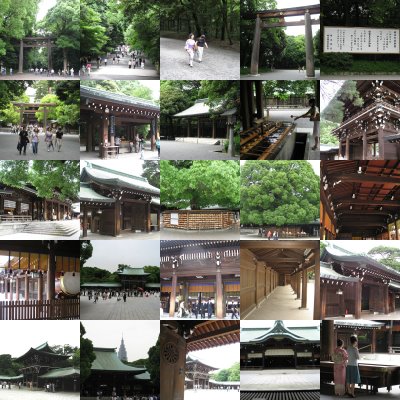
I had promised myself that I would visit Meiji Shrine. So the 3nd morning, I came down early to the lobby at 24th floor of the hotel tower to take the elevator down to ground floor. It was a surprise when I was accompanied by a couple all decked in Japanese wedding finery - kimono and all - with several retinues. I was so tempted to take a picture of them, but that would be simply rude. Imagine the greater surprise I had when I entered the sacred grounds of Meiji Shrine, after a long walk of some 1 hour on the route from the main Shrine Gate to the Shrine itself, and saw not one, but several wedding couples with all their long processions of relatives, all dressed in Japanese traditional costumes. I had a field day with my camera then.
(Meiji Shrine - Grounds and long walk to the main Shrine. Note the breathtaking architecture.)
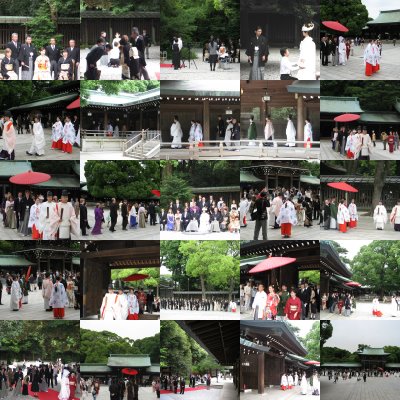 Weddings at Meiji Shrine - I guess it must have been an auspicious day for nuptials. I witnessed no less than some 8 couples going through the traditional wedding procession. It is interesting, the procession - the family members of the bride and groom will be lined up behind them respectively, and then they would proceed from a palace hall on the right of the grounds into the main plaza in front of the Shrine, and then up to another palace hall on the left of the grounds towards the inner recess of the Shrine to pray. After that, the procession will retrace their route back to the original hall, with closing words by the Priest to the bride and groom, followed by numerous bowings from both families. Then, they move on to that their family portrait for the occasion. Each wedding procession takes about 15 minutes, and it is superbly timed to avoid any clashes of schedules between the different couples. Most quintessential too, the processions, almost like period dramas. (NOTE: zoom in and scrutinise the wedding couples - there is something of interest here.)
Weddings at Meiji Shrine - I guess it must have been an auspicious day for nuptials. I witnessed no less than some 8 couples going through the traditional wedding procession. It is interesting, the procession - the family members of the bride and groom will be lined up behind them respectively, and then they would proceed from a palace hall on the right of the grounds into the main plaza in front of the Shrine, and then up to another palace hall on the left of the grounds towards the inner recess of the Shrine to pray. After that, the procession will retrace their route back to the original hall, with closing words by the Priest to the bride and groom, followed by numerous bowings from both families. Then, they move on to that their family portrait for the occasion. Each wedding procession takes about 15 minutes, and it is superbly timed to avoid any clashes of schedules between the different couples. Most quintessential too, the processions, almost like period dramas. (NOTE: zoom in and scrutinise the wedding couples - there is something of interest here.) 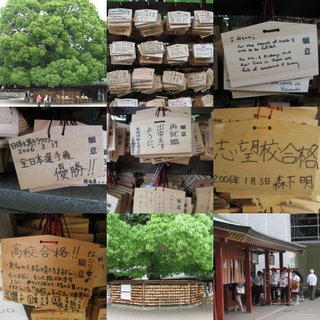
The Japanese really have a penchant for making earnest wishes for every aspect of their lives. I encountered that at the Asakusa Sensoji and also at Meiji Shrine. I was to encounter it later at Tokyo Tower itself too. Reading the wishes of those who prayed at Meiji Shrine reminds me of how focused and purposeful the Japanese are. They pray for success in studies, exams, marriage, and jobs. Many tourists added to the wish blocks too. One particularly caught my eye, 'I dream; for the dreams of those I love to be fulfilled...' That was really poetic.
 One morning (the 4th, I believe), I decided to trek my way to this gigantic temple in the distance which I had seen from my 36th storey room. I had not any inkling what its name was, where it exactly was situation. So I simply set out in the vague direction of that temple. Along the way, I tarried along the little streets and chomes of Tokyo, and decided to create a photo portfolio of the vending machines I encountered along the way. Afterall, Tokyo is known as the land of vending machines. Indeed, one store which I termed the mother of all vending machines site had 7 vending machines of drinks for the consumer to choose from. Amazing.
One morning (the 4th, I believe), I decided to trek my way to this gigantic temple in the distance which I had seen from my 36th storey room. I had not any inkling what its name was, where it exactly was situation. So I simply set out in the vague direction of that temple. Along the way, I tarried along the little streets and chomes of Tokyo, and decided to create a photo portfolio of the vending machines I encountered along the way. Afterall, Tokyo is known as the land of vending machines. Indeed, one store which I termed the mother of all vending machines site had 7 vending machines of drinks for the consumer to choose from. Amazing.(The vending machines... Which is the mother of all vending machines sites? & Typical Japanese side streets... )
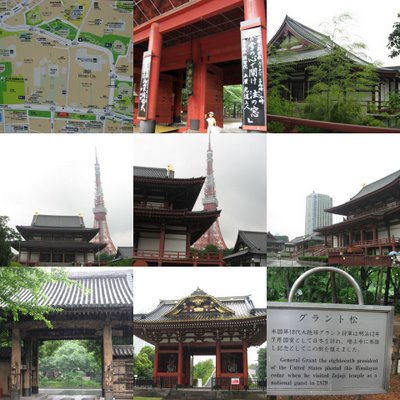 I finally reached the temple (Zozo-j Temple) after some 2 hours, and discovered that it had once belonged to the Shogun clan which had ruled Edo (former name of Tokyo) for centuries before the Meiji Restoration. That day, the main hall was under preparations for some anniversary memorial for the Tokugawa Clan (Shogun's Clan). Today, the grounds have shrunk, part of it taken over by the Prince Hotel, but the grounds are still extensive, and there are 3 main palace areas. The old burial gounds of the clan lie behind the main palace hall, and are still well kept. Now isn't that simply satisfying, for a vague journey with a vague direction had yielded something concrete, indeed something valuable - an unplanned encounter with a main part of Japanese history. And Tokyo Tower is just some distance away from the temple, most visible here, towering over the main temple hall itself. It provides a most perceptive contrast of new and old, in particular reminding one of how the Shogun's demise and the Meiji Restoration were what made the industrial progress in Japan possible.
I finally reached the temple (Zozo-j Temple) after some 2 hours, and discovered that it had once belonged to the Shogun clan which had ruled Edo (former name of Tokyo) for centuries before the Meiji Restoration. That day, the main hall was under preparations for some anniversary memorial for the Tokugawa Clan (Shogun's Clan). Today, the grounds have shrunk, part of it taken over by the Prince Hotel, but the grounds are still extensive, and there are 3 main palace areas. The old burial gounds of the clan lie behind the main palace hall, and are still well kept. Now isn't that simply satisfying, for a vague journey with a vague direction had yielded something concrete, indeed something valuable - an unplanned encounter with a main part of Japanese history. And Tokyo Tower is just some distance away from the temple, most visible here, towering over the main temple hall itself. It provides a most perceptive contrast of new and old, in particular reminding one of how the Shogun's demise and the Meiji Restoration were what made the industrial progress in Japan possible. 
And so I faithfully trotted my way to the Tower. It was a rainy day, showers. I bought one of those characteristic plastic umbrellas that the Japanese convenience stores sell. Up the tower, it was all foggy, and I spent a large amount of time awaiting the fog to disperse. There was another discovery up there - a wish area for the success of the nippon soccer team for the world cup. Yes, I left my imprint there as well.
Nippon Samurai Blues craze in Tokyo. Japan soccer team members and stars were splashed all over TV programmes, magazines, banners, etc.
Wishing area for Nippon Soccer Team at Tokyo Tower ... I left a wish slip too...
 (Nippon Samurai Soccer Stars Banners hanging inside TV Asahi Building Lobby. )
(Nippon Samurai Soccer Stars Banners hanging inside TV Asahi Building Lobby. )Then, the very next day was the match of Japan against Australia. That afternoon, companies were giving freebies of mineral water with the nippon soccer logo on the labels, and numerous office executives on their breaks were lining up to collect one each. That, I did too. The trains in the evening were really packed, quite early for the matter. The train pushers, those legendary uniformed guys with gloves, were out in full force pushing and shoving the passengers into the packed trains at 7 plus in the evening, all in an effect to get everybody back home to catch the Japan match. It did not end well, as we know by now, with the 3 goals scored by Australia within the last 10 minutes. I could not believe my eyes, neither could I believe how dejected and ill-spirited the Japanese players were at the upset goals. I mean, they should have continued with the fighting spirit instead of shaking their heads at every single additional Australian goal. I should have thought that the Japanese fighting spirit would prevail. But it seemed that once they met their first upset defeat, they crumbled. It was a bleak day the next morn for the Japanese.
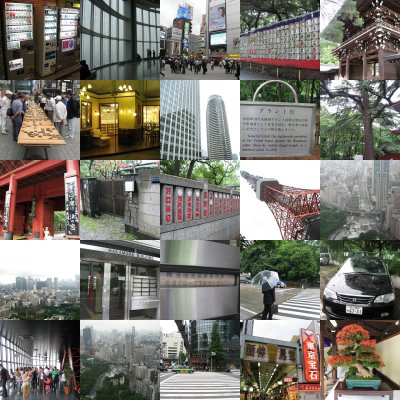
TOKYO: A mosaic of contrasts. Modern versus traditional; cutting age versus aging population; individualism versus community spirit...
Ok.. that's bout it for part 1.. tired and gona continue another day.
DAY 1: Royal Park Shiodome Tower (my hotel), Ginza, Asakusa & Sumida River
DAY 2: Roppongi, TV Asahi, Shimbasi, Ueno
DAY3: Harajuku, Meiji Shrine, Ginza
DAY4: The Walk to Zozo-j Temple, Hibiya Park, Tokyo Tower, Akirabaha
DAY5: Odaiba, Fuji TV, Shimbasi, Ueno
DAY 6: Ginza, Imperial Palace Vicinity

0 Comments:
Post a Comment
<< Home